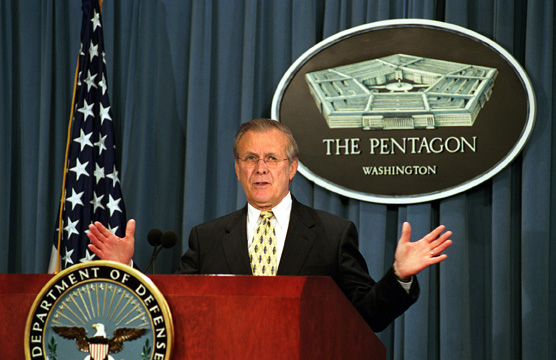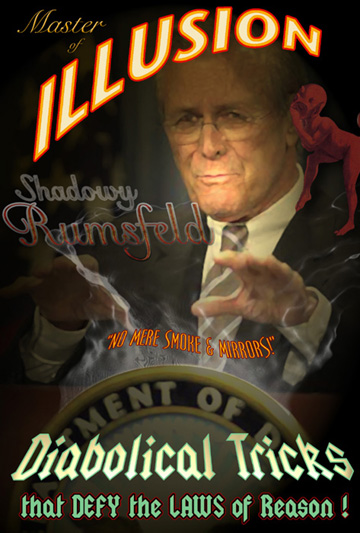
|
Applied Magic(k) #3 printed
in Arthur
Magazine - #23, July 2006
But words and symbols continue to work their magic(k) regardless of whether or not we believe in them. Look at the outcry against Madonna singing from the cross or riots in response to Mohammed cartoons and we begin to see that the power of symbols is anything but make-believe. For those who insist that religious sensitivities are a cheap shot, consider this secular example: For over 150 years the United States had a Department of War. During much of that time U.S. foreign policy consisted of "neutrality" and therefore the DoW did not lend any direct military support in foreign conflicts. World War II put a definitive end on U.S. neutrality once and for all, and in 1947 the DoW was renamed the "National Military Establishment" or NME (pronounced "enemy"). Realizing the error of their acronym, politicians again changed the name in 1949 to what we know today as the "Department of Defense." More than half a century after "war" became "defense" the DoD sits deep within the Pentagon planning "pre-emptive defensive strikes" while waving a flag with fifty pentagrams on it.
Ok, so spin-doctoring isn't exactly the same thing as witch-doctoring. Still, most performing magicians (conjurors) won't deny the power of language. And few will debate the fact that word choice makes a difference when presenting a trick. Many will even insist that the "patter" makes or breaks the illusion. More to the point, the strength and efficacy of a trick is often closely tied to the audience's ability to relate both specifically and abstractly to the overall illusion. This is precisely why magic with money tends to hold people's attention more than tricks with handkerchiefs. Money is already a loaded symbol, whereas how many people revere a silk hanky? If you still maintain your doubts, try first performing card tricks over lunch and then later in the middle of a poker game. Any guesses on which audience gets more riled up when you magically produce four aces from up your sleeve? Admittedly, the ability to make a scrap of green paper covered in Masonic symbols disappear doesn't quite live up to our childhood expectations of magic(k). Perhaps this is especially true because we become adept at making dollars disappear all the time. As we grow older, we become initiated into the Church of Consumerism. It is here that we become increasingly distrustful of anything "magical" since we quickly find the mystique tarnished by a barrage of commodities gilded in glitz. Yesteryear's potions, spells, and apparatuses are hawked as today's energy drinks, pharmaceuticals, and hi-tech gizmos. Finding ourselves surrounded by "magic" cleaning supplies, "power" tools, and Lucky Charms, it's easy to concede that there's no such thing as "real" magic(k). Yet, ironically this is where some of the oldest forms of magic(k) still thrive today. Emblazoned on nearly every product, within every corporation, and tied to commodities strewn across the globe one finds logos. We tend to ignore them; or at least we think we do. However, too much consideration goes into the creation of an effective logo to be ignored. Beyond mere aesthetics, a logo is designed to perform a particular function quite similar to that of a magical sigil. Specifically, the fundamentals of logo design stress three distinct phases of association: 1) contextual or relative association; 2) direct or habitual association; and 3) autonomic or hypnotic association. In contextual or relative association the logo appears in the same context as the product. Thus, the consumer understands that there is a relationship between the logo and the product, thereby making it easier for the consumer to locate an identical or similar product in the future by seeking out the logo (i.e. - look for the golden arcs and find the freedom fries). In the second phase, direct or habitual association, the logo increases its scope of influence. Through repeated exposure to the logo, the consumer now identifies directly with the logo and no longer differentiates between the logo and the product represented by the logo. The logo has become a direct stand-in for the product itself. Through force of habit the logo now represents a standard (albeit an irrational one not often governed by actual quality) by which all other similar products are measured and found lacking. (i.e. - why do you favor one brand of electronics over a brand you have never heard of or seen before? And, why is it "cool" to where the logo of that company on your t-shirt?). And finally, there is autonomic or hypnotic association. Like Pavlov's dogs who began to salivate at the sound of the dinner bell, the consumer who has reached a state of hypnotic association will begin to physically manifest a desire for the product upon merely seeing the associated logo. In such cases, the consumer's willingness to act on this irrational desire happens because s/he has not only come to associate the logo with the product but also with the feeling(s) s/he's attached to the product (status, sex appeal, satiety, power, success, etc). Even a momentary, peripheral glimpse of the logo may be enough to make the consumer hunger for the product and act towards quenching the thirst of an irrational desire. To the consumer, the impulse will seem completely logical, and s/he may not even be consciously aware of having seen the logo only moments before. As we lift our gaze out of the marketing primers and PR manuals and flip through the pages of grimoires and spell books, we begin to see the magic(k) ties that bind logos and sigils. Sigils have been used for thousands of years, but the contemporary use of sigils in ritual magick owes a great debt to the early 20th Century artist and occultist, Austin Osman Spare. In its traditional form, a sigil is basically an abstract mark or symbol that is magically charged through a process of association with one's desires. By reducing an idea to a single design, the concept is mentally planted in a non-linguistic manner and left to blossom over time. This magical seed can be further fertilized by focusing on the design (not the idea represented by the design) during a heightened state of arousal (pleasure, pain, excitement, exhaustion, fear, ecstasy, etc.). A.O. Spare recommends using your orgasm to charge the sigil. Essentially a meditative tool used to focus one's conscious and subconscious attentions towards manifesting a specific result, a sigil can be made by anyone for any reason. The sigil has no power of its own, and means nothing to those who have no associations with it. However, a sigil that is unleashed and gains popular recognition can maintain a power that is both subjective and collective. Although Madison Avenue mages now refer to spells, incantations, and sigils as slogans, jingles, and logos the effects are just as powerful as ever. Authority commonly wields power through the manipulation of sign systems which individuals are collectively programmed to accept as valid structures of discipline and control. Fortunately, magic(k) is an open-source technology that doesn't exclusively belong to advertising execs and policy-makers. Outlined here is a sequence of actions that will effectively illustrate the aforementioned dynamics. Further, the following sequence of actions also serves as a general spell for revealing that "authority" is a subjective force, and that victory is awarded to those who play the 'Sign Game' best. While strict adherence to the spell will often yield successful results, an accurate understanding of the underlying principles will allow for delightful adaptations and diverse applications. Have fun & Good luck! And please let us know of your results by emailing us at: goodluck@tacticalmagic.org
|
|||

